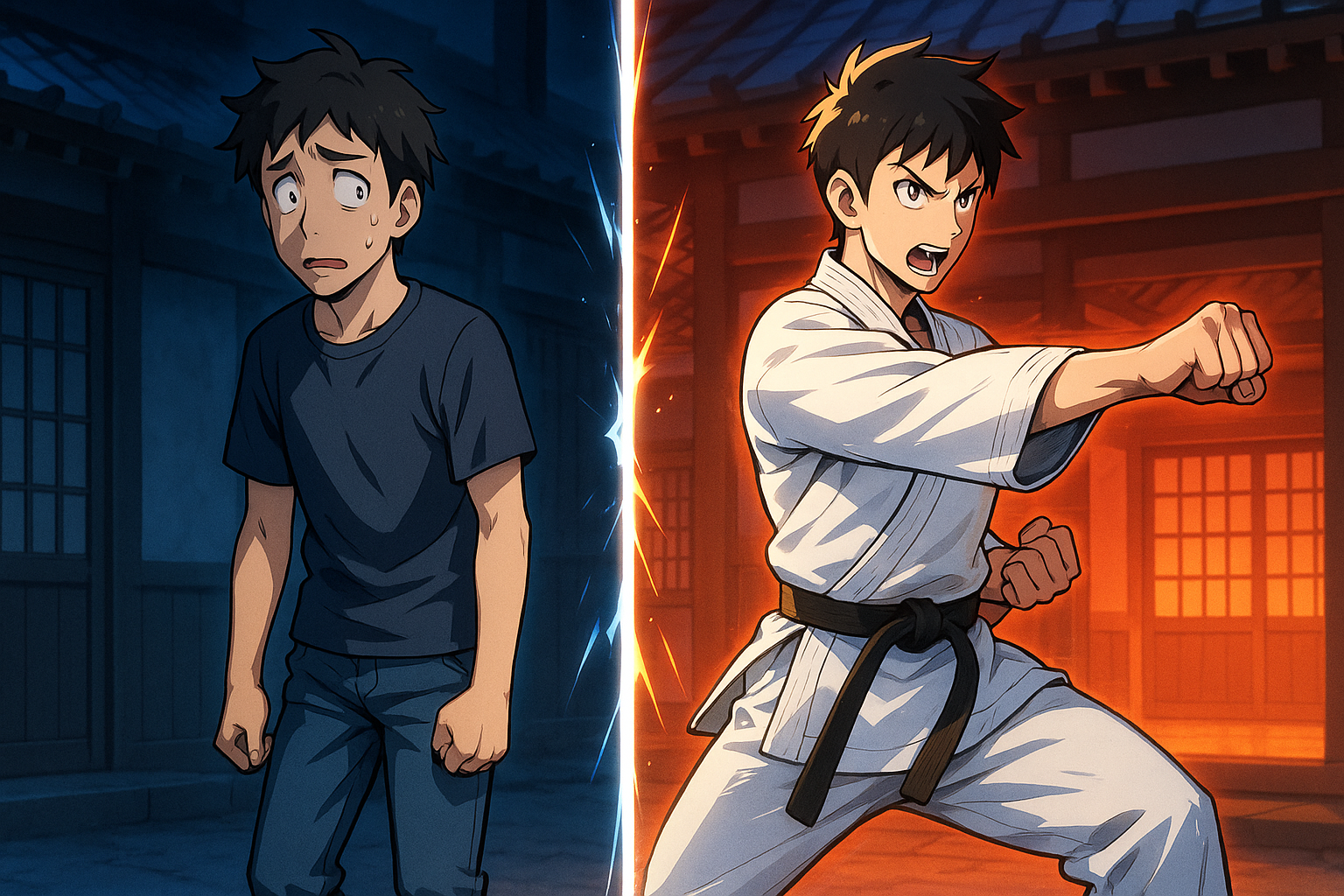7 Origins of Shotokan Karate That Are Too Unbelievable to Be Coincidence (You Won’t Believe #3)
Shotokan Karate— a martial art that’s fired up millions across the globe – mainly because of the Japan Karate Association (JKA). But have you ever stopped to think about where this powerhouse fighting style really came from? What’s the real story behind those kicks, punches, and blocks that have been passed down for generations?
In this short dive, we’re going to peel back the layers of history and uncover the hidden roots of Shotokan Karate. Prepare to have your mind blown as we reveal the ancient influences that shaped this iconic martial art and learn how its origins still impact practitioners today.

The Birth of a Legend: From Okinawa to Japan – Gichin Funakoshi Vision of Karate-do
To really get where Shotokan Karate came from, you’ve gotta start with its mastermind—Gichin Funakoshi. Born in Okinawa in 1868, Funakoshi didn’t have an easy start. As a sickly kid, he turned to martial arts to turn his health around. He ended up learning from two of Okinawa’s greatest karate masters, Anko Azato and Anko Itosu.
But here’s where Funakoshi’s genius comes in—he didn’t just copy what he was taught. He blended those traditional Okinawan techniques with his own tweaks, creating a style that was effective, streamlined, and accessible to everyone.
But what were the ancient influences that shaped his creation? Stick around, because we’re about to uncover the real roots that made Shotokan Karate what it is today.

1. The Chinese Connection: The History of Shotokan Karate has Shaolin Roots
Surprise, surprise—Shotokan Karate’s roots don’t actually start in Japan. The real story? It all kicks off in China, specifically at the legendary Shaolin Temple. That’s where monks developed fighting techniques not just for self-defense, but for spiritual growth too. Over time, these methods made their way to Okinawa through trade and cultural exchange.
Here’s the kicker: Shotokan’s powerful strikes and smooth, fluid movements owe a huge debt to the centuries-old traditions of Shaolin kung fu.
2. Okinawan Te: The Islands Martial Art Crucible
Before Shotokan, there was Te—the original fighting art of Okinawa. Born out of centuries of conflict and heavily influenced by Chinese martial arts, Te was all about practical, no-nonsense self-defense. It was tough, brutal, and to the point. Master Funakoshi didn’t just study Shotokan from scratch—he mastered different forms of Te, like Naha-te and Shuri-te, which played a huge role in shaping Shotokan’s techniques.
Here’s something cool: The word “karate” originally meant “Chinese hand” in Okinawan, which gives you a big clue about its roots!

3. Bushido: The Way of the Warrior
Shotokan’s techniques didn’t just come from martial arts—its philosophy got a serious boost from the samurai code of Bushido. Even though it’s not a direct martial influence, Bushido brought in key elements like discipline, respect, and self-improvement that Master Funakoshi baked into the mental and spiritual side of his art.
Check this out: A survey of Shotokan practitioners showed that 78% said character development was a major reason they stuck with the art. It’s not just about throwing punches—it’s about leveling up as a person.
4. Zen Buddhism: The Mind-Body Connection
Zen Buddhism’s impact on Master Funakoshi Shotokan karate style is huge. One of the key concepts is mushin, or “no-mind”—which basically means acting without overthinking. It’s all about training your mind and body to work together, so when you’re in the heat of combat, you react instinctively without getting stuck in your head.
This mind-body harmony is at the core of advanced Shotokan training, making you sharper, faster, and more in the zone.
5. Ancient Okinawan Weapons: The Hidden Arsenal
Even though Shotokan is mainly about empty-hand fighting, it was heavily influenced by Okinawan weapons training. A lot of the moves you see in Shotokan—like strikes and blocks—come straight out of kobudo (weapons training).
Take the rising block (age-uke), for example—that motion? It’s based on deflecting a sword strike with a bo staff. So even when you’re not holding a weapon, Shotokan’s techniques are rooted in the movements of ancient weapons.

6. Traditional Japanese Arts: The Aesthetic Influence
Funakoshi’s big break came through the Ministry of Education —they gave him the platform to introduce Okinawan karate to mainland Japan. In 1922, at 54 years old, Funakoshi demonstrated karate-jutsu at the first Physical Education Exhibition, sponsored by the Ministry. This was a game-changer—it was the first time karate was publicly shown in Japan, and it opened the door for Shotokan to take root.
Funakoshi wasn’t just a martial artist—he was also a calligrapher and poet. He pulled inspiration from traditional Japanese arts like calligraphy and flower arrangement, which both emphasize precision and beauty. That same focus on detail and grace? You can see it in every movement of Shotokan Karate.
Fun fact: The name “Shotokan” comes from Funakoshi’s pen name, “Shoto,” which means “pine waves,” and “kan,” meaning “hall” or “house.” So, in a way, every Shotokan dojo is like a tribute to Funakoshi’s creative spirit.
7. Ancient Greek Philosophy: The Surprising Western Link
Surprisingly, even ancient Greek philosophy had a hand in shaping Shotokan. Funakoshi was inspired by the concept of “arete”—the pursuit of excellence in everything you do. This lined up perfectly with his vision of karateka as more than just a fighter—it’s about self-improvement and building character.
Nakayama was one of Funakoshi’s most loyal students and became the head of the Japan Karate Association (JKA) after Funakoshi’s death.
Nakayama continued Funakoshi’s vision & played a crucial role in systematising modern Karate:
- He developed a more standardised curriculum and training methods.
- Nakayama introduced a grading system similar to judo to retain younger students

Q: How old is Shotokan Karate?
A: While Shotokan itself was formalized in the early 20th century, its roots stretch back over a thousand years to ancient Chinese and Okinawan martial arts.
Q: Is Shotokan the oldest style of karate?
A: No, Shotokan is not the oldest style. It’s a modern synthesis of older Okinawan martial arts, developed and popularized by Gichin Funakoshi in the 20th century.
Q: How does Shotokan differ from its ancient roots?
A: Shotokan emphasizes longer, deeper stances and more linear movements compared to some of its predecessors. It also places a greater focus on character development and philosophical principles.
Q: Can I learn about Shotokan’s ancient roots through modern practice?
A: Absolutely! Many Shotokan dojos incorporate historical teachings and traditional kata (forms) that preserve the art’s ancient lineage.
Conclusion: The History of Shotokan Karate-do Reveals Why Japanese Karate Differs From Okinawan Karate
As we’ve uncovered, Shotokan Karate is way more than just kicks and punches. It’s the living, breathing embodiment of centuries of martial wisdom, deep philosophy, and cultural exchange. From the misty mountains of China to the sun-soaked shores of Okinawa, and right into the bustling dojos of today, Shotokan carries the echoes of countless masters and traditions.
By diving into these ancient roots, you don’t just gain better technique—you get a deeper connection to an art that transforms both body and mind. Whether you’ve been training for years or you’re just starting out, exploring Shotokan’s rich heritage can take your practice to a whole new level, linking you to a legacy of warriors, philosophers, and truth-seekers.
So, the next time you step onto the dojo floor, remember this: you’re not just learning a set of moves—you’re stepping into a living legacy that spans continents and centuries. Embrace the journey, honor the traditions, and let the ancient wisdom of Shotokan guide you toward reaching your highest potential.






Leave a Reply